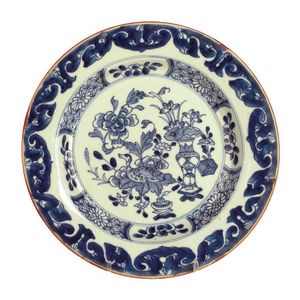Gilded Imari Garden Plate, c.1820
You must be a subscriber, and be logged in to view price and dealer details.
Subscribe Now to view actual auction price for this item
When you subscribe, you have the option of setting the currency in which to display prices to $Au, $US, $NZ or Stg.
- Gilding - Gilding is a method of ornamentation whereby a thin sheet of gold metal is applied to items made of wood, leather, ceramics, glass and silver for decorative purposes.
For furniture including mirrors, the sheet of gold is usually applied over a coating of gesso. Gesso is a mixture of plaster of Paris and gypsum mixed with water and then applied to the carved wooden frames of mirrors and picture frames as a base for applying the gold leaf. After numerous coats of gesso have been applied, allowed to dry and then sanded a coat of "bole", a usually red coloured mixture of clay and glue is brushed on and allowed to dry, after which the gold leaf is applied. Over time parts of the gilding will rub off so the base colour can be seen. In water gilding, this was generally a blue colour, while in oil gilding, the under layer was often yellow. In Victorian times, gilders frequently used red as a pigment beneath the gold leaf.
Metal was often gilded by a process known as fire gilding. Gold mixed with mercury was applied and heated, causing the mercury to evaporate, the long-term effect of which was to kill or disable the craftsman or woman from mercury poisoning. The pursuit of beauty has claimed many victims, not the least of which were the artists who made those pieces so highly sought after today. - Faux - A French word meaning "false", but when used in decorative arts, the intention is not to deceive, but to simulate the decorative effects of the more expensive material it is imitating. The term " faux bois" meaning "false wood" refers to a furniture item that has been decorated with a marked grain (woodgrain finish) to imitate a more expensive timber.
- Chinese Cracked Ice Motif - The Chinese cracked ice decorative motif is a traditional design that was commonly used in Chinese art and architecture, particularly in the Ming and Qing dynasties (1368-1912). The motif is characterized by a pattern of small, irregular cracks or fissures that resemble broken ice.
The cracked ice motif was often used in a variety of decorative arts, such as pottery, porcelain, lacquerware, and furniture. It was also used in architectural elements, such as floor tiles, roof tiles, and wall panels. The motif was typically created by carving or incising the surface of the material, and then filling the cracks with a contrasting color, such as black or gold.
The cracked ice motif symbolizes the idea of "coolness" in Chinese culture, and was often used in architectural elements to create a sense of coolness and shade, especially in hot climates. In decorative arts, it is considered as an elegant and refined design that evokes the natural beauty of ice.
This item has been included into following indexes:
Visually similar items

Early 18th century Chinese Imari plate or shallow dish. Decorated with underglaze blue, over glaze iron red and gilding. The central decoration of flowers in a vase. An elaborately decorated condiment rim. The underside with double ring circles and three u

A late 18th century/early 19th century Chinese blue and white export plate, decoration of flowering vase, florals and precious objects to the centre, decorated border with iron red edge, small old repairs to rim. Diameter 22.3 cm

A late 19th century Chinese famille rose tray of shaped oval form, the flat surface with four panels including figures, birds and florals, gilt enrichments. 24 x 27.5 cm

Small antique Chinese export saucer dish profusely decorated in Canton famille rose enamels with the 100 butterfly design. Late Qing or early Republic period. Some minor spots of wear. Diameter 13.5 cm
